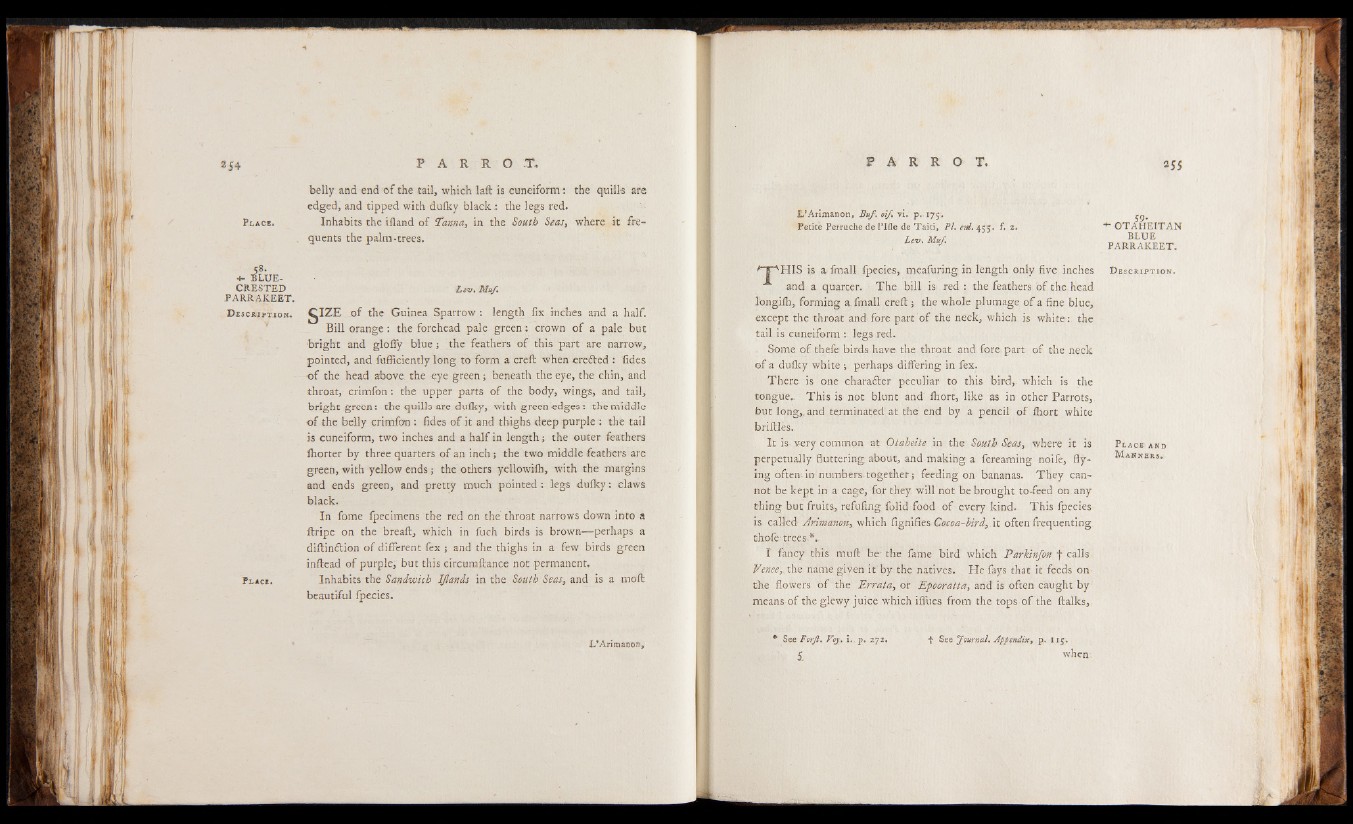
Pla c e.
58.
+- BLUE-
CRESTED
PARRAKEET.
D e sc r jp 'tjon-
P l a c i .
belly and end of the tail, which laft is cuneiform: the quills are
edged, and tipped with dufky black.: the legs red.
Inhabits the ifland of Tama, in the South Seas, where it frequents
the palm-trees.
Lev. Mu/.
SIZ* of the Guinea Sparrow : length fix inches and a half.
Bill orange : the forehead pale green: crown of a pale but
bright and gloffy blue; the feathers of this part are narrow,
pointed, and fufficiently long to form a creft when erefted : fides
of the head above the eye green; beneath the eye, the chin, and
throat, crimfon: the upper parts of the body, wings, and tail,
bright green: the quills are dufky, with green edges: the middle
o f the belly crimfon: fides of it and thighs deep purple : the tail
is cuneiform, two inches and a half in length; the outer feathers
fhorter by three quarters of an inch; the two middle feathers are
green, with yellow ends; the others yellowilh, with the margins
and ends green, and pretty much pointed : legs dufky: claws
black.
In fome fpecimens the red on the throat narrows down into a
ftripe on the breaft, which in fuch birds is brown— perhaps a
diftin&ion of different fex ; and the thighs in a few birds green
inftead of purple, but this circumftance not permanent.
Inhabits the Sandwich IJlands in the South Seas, and is a moll
beautiful fpecies.
L’Arimanon,
IL’Arimanon, Buf. oi/ vi. p’J 1751.
Petite Perruche de PIfle de Taiti, PI. etd. 455. f. 2.
Lev. Muf.
' “p H I S is a fmall fpecies, meafuring in length only five inches
■ *" and a quarter. The bill is red : the feathers of the head
lbngifh, forming a fmall creft j the whole plumage of a fine blue,
except the throat and fore part of the neck, which is white:, the
tail is cuneiform : legs red.
Some of thefe birds have the throat and fore part of the neck
of a dufky white ; perhaps differing in fex.
There is one character peculiar to this bird, which is the
tongue.. This is not blunt and fhort, like as in other Parrots,
but long,, and terminated at the end by a pencil of fhort white
briftles-
It is-very common at Otaheite in the South Seas, where it is
perpetually fluttering: about, and makihg a fcreaming noife, flying
often in numbers together; feeding on bananas. They cannot
be kept in a. cage, for they, will not be brought to-feed on any
thing but fruits, refufing folid food of every kind. This fpecies
is. called Ar.imanon, which fignifies Cocoa-bird, it often frequenting
thole trees.*.
I fancy this muft be- the fame bird which Parkinfon f calls
Venee,., the name given it by the natives. He fays that it feeds on
the flowers of the' Errata, or Epooratta, and is often caught by
means of the glewy juice which iflues from the tops of the ftalks,
59-
•*- OTAHEITAN
BLUE
PARRAKEET.
D e s c r i p t io n .
P la ce and
M a n n e r s .
■ f See Journal. Appendix,